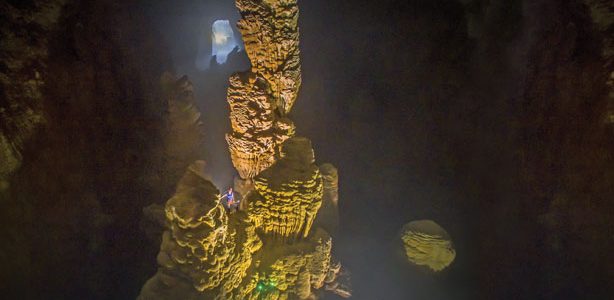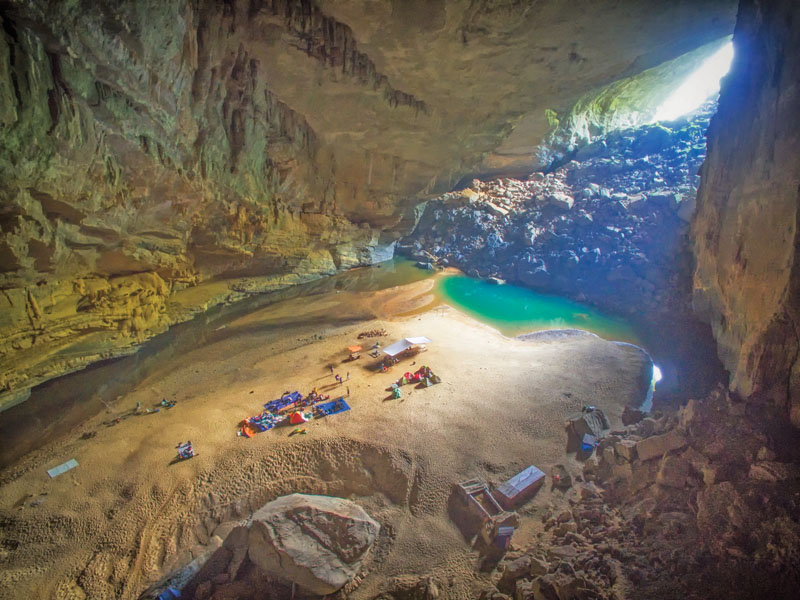Underground Adventure
When I learned about the ABC Good Morning America’s project to do a live broadcast out of a very remote location in central Vietnam, I was immediately excited and intrigued. I knew this would be a beautiful project allowing me to expand my horizon by going to a country I had never visited. Little did I know that this would turn out to be the most challenging, fascinating and mind-blowing experience of my life so far.
The survey trip
In the middle of April a small ABC team and I met in Hong Kong and together we traveled to Hanoi, Vietnam. This was the team doing the survey trip; the trip that determined if this project would actually be executable. We needed to see if we could get a view of one of the few available satellites needed for a live broadcast at a specific location. But we also needed to get an understanding of how difficult it would be to get a lot of equipment to that location and how we would actually pull this off.
Did I mention that the location we were about to visit was deep inside the jungle? If that wasn’t challenging enough, we were about to go underground, below the surface: into the world’s third and largest caves, Hang En and Son Doong. Now that really added some complexity, uncertainty, challenges and worries.
For the survey trip I brought one DJI Inspire 1 with me. DJI had also mailed a brand-new Phantom 3 Professional from their factory to Vietnam. Unfortunately, the shipment got stuck in customs and never made it to our location. To make things worse, my DJI Inspire (inside a GoProfessional case) got lost in Hong Kong and also did not arrive in Vietnam. And that’s where I learned how wonderful and helpful the Vietnamese people are. One of DJI’s brand-new dealers connected up with us and delivered an Inspire 1 with batteries to our hotel. Just like that—without hesitation or payment.
We continued on to Dong Hoi and after an hour drive settled into our home base at Oxalis Adventure, just outside the Nha-Kė Bàng National Park. It was time to set-up the Inspire, test everything and prepare for the grueling hike through the jungle and then into the two cave systems.
Even though we were a small group, it took a big team to make all of this possible. We had porters helping us with our equipment, carrying food, tents and other necessary items. The morning we left for the jungle, we put everything into big rice bags and the porters created backpacks by adding straps to the bags. While we were doing final packing, I got word that my case had been found and was actually being delivered to the local airport. A team of porters would wait behind and then take the case with them through the jungle.
I strapped the Inspire onto an Airwheel backpack, which I had brought with me. Once we arrived at the campsite inside Hang En, there was a huge cavern with sandy beaches with beautiful turquoise water, I quickly unpacked and got the Inspire ready.
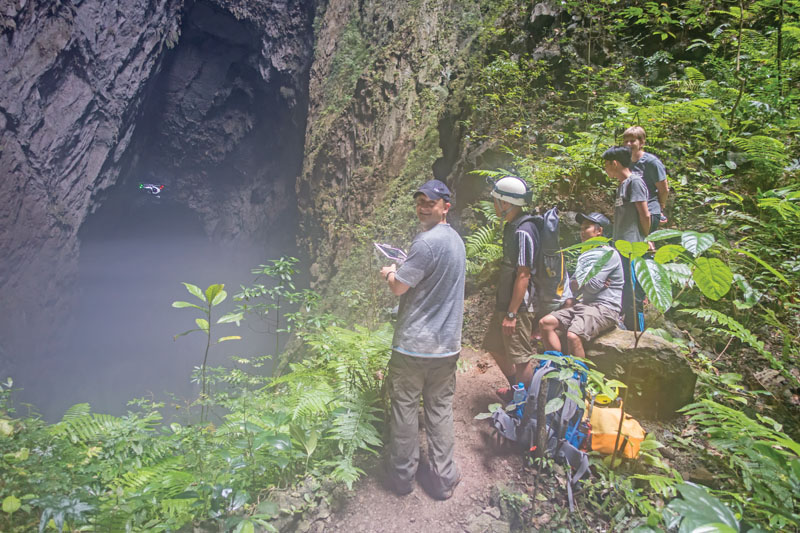
The author flies a DJI Inspire below the first limestone depression inside Son Doong, the world’s largest cave. The cave has its own weather system and is very humid.
First flights
The first few flights there made me feel like a novice; the winds were pushing my rig in different directions and visually it was very hard to determine proximity to the wall or the ceiling. It took me a couple of batteries to get the hang of it. There is a big opening about 500 feet and I ventured closer to that opening. The incoming wind meant that you could not let go of the sticks or the machine would immediately get pushed around. I remember those first few flights I was very tense and my hands were shaky.
Inside a cave there are several big challenges that need to be overcome. First there is the physical challenge. This location is a long way away from civilization and meant that we had to hike and trek through the deep jungle just to get there. Once there we had to climb into the caves and spend days underground. Then there is the mental challenge, as well as fatigue, dehydration, heat and humidity, and a very harsh terrain that impacts your state of mind. After hours of hiking, climbing, carefully trekking inside a dark and dangerous cave, drenched in sweat, covered in dust, with wet boots, then you have to unpack your flying machine and fly. This isn’t your normal everyday flying!
First and foremost, you have no GPS signal inside a cave. There are barely any flat surfaces to take off from or land on, it’s dark and gloomy and often times you have condensation and fog. You have to be very focused and on top of your game. It’s mentally challenging. Then you also have to deal with equipment challenges: the heat, the humidity, the dust, and the fog all impact the performance of your machine. And then there is the challenge of the location itself. Flying inside a cave is nothing like I had expected. I had flown indoors many times and I am comfortable to do my rounds in a big room or hallway. But a cave is a different world. And over the next month I would really learn that flying in a small cave is much easier than in a large one. As contradictory as it sounds, flying in a cave the size of Son Doong is extremely difficult. For starters you have very little depth perception—especially when your machine is 500 or 1000 feet away. Then, because of the lack of GPS signals, you have to fly in ATTI mode, a mode that allows the machine to drift. You drift in the direction you are flying and drift with very interesting wind currents. Your eyes are glued to the screen for the most part. But every 15 or 20 seconds, I would look up and get a view from where I was standing. The DJI Inspire has a 94-degree field of view with pretty much no distortion. That helped getting a better sense of seeing obstacles. However, the limited field of view meant that you don’t know what is on the side or above it. Sometimes I had to just stop in midair and see what’s around me to know how close or far away I was from the wall or the ceiling.
Who would have thought that a stabilized gimbal would be a disadvantage? Yes, when you fly in scales like these huge caverns, you barely noticed a drift left or right on screen. Everything is so smooth, until you almost touch a wall. You have to keep yourself relaxed, shoulders down, hands holding the radio not too tightly. I learned that a wide stance was almost always the best position as I rarely had the luxury of a flat surface to stand on. At times I would stand or kneel inches from a big drop or a slippery incline. Sometimes I had a porter hold my shoulders so I wouldn’t tip over as I transferred my point of view from the screen to my aircraft.
The survey trip turned out to be a big success and we all determined that a live broadcast could be done out of the Hang En cave and could use the amazing pre-taped footage of Son Doong from the Inspire. The goal also was to bring a few Phantom 3s as they would come in handy to tape shots ahead of time. For the live broadcast, we would use the Inspire 1 with its HDMI going straight into the ABC equipment. We all went home to prepare everything needed.
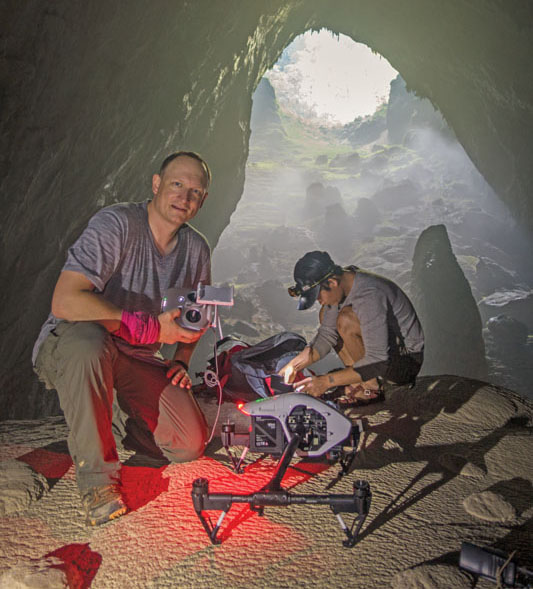
The author and an Oxalis Adventure porter set up the DJI Inspire 1 for a flight below the second limestone depression inside Son Doong.
The Production Trip
Two weeks later we all met up in Hanoi again. This time the team was larger with more experts and technicians. On the production trip I also had my colleague Ferdinand Wolf from Skynamic with me. Ferdinand, in my opinion, is very likely the world’s best drone pilot. He also has strong technical skills and together with my abilities, we were a very strong team.
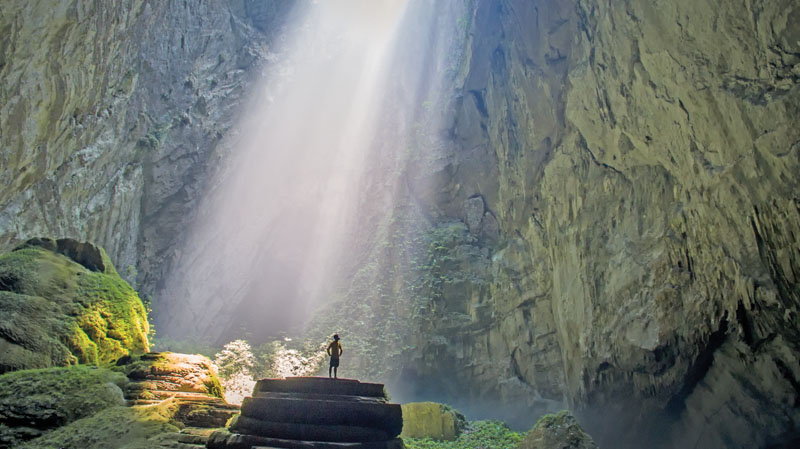
An Oxalis porter stands on top of a huge stalagmite below the beam of light that shines through the big opening in the cave ceiling 1,000 feet above.
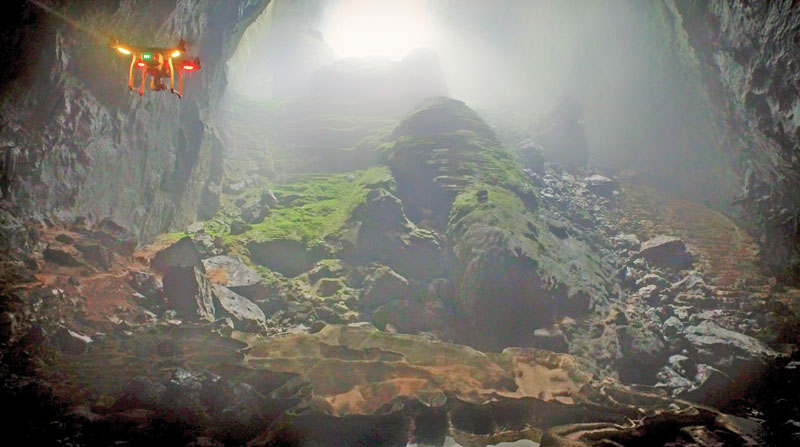
The DJI Inspire 1 flies behind the DJI Phantom 3 to capture the ascent up to the top of the stalagmite.
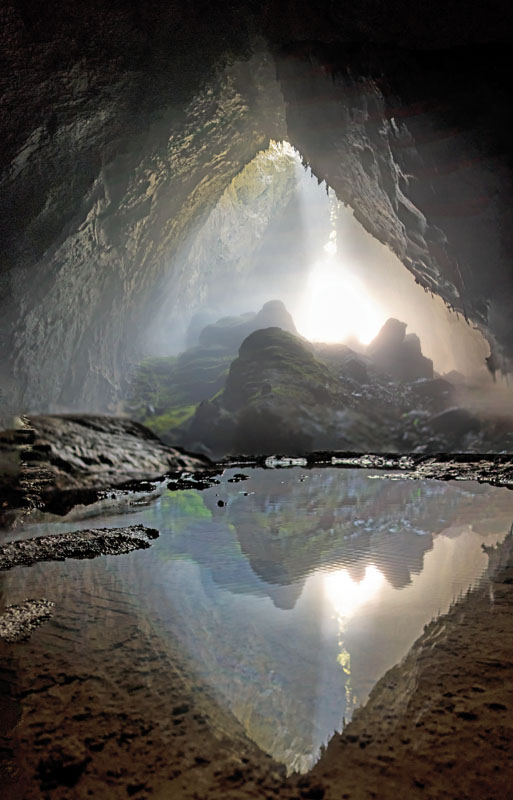
Vertical panorama from below the stalagmites, which are located below the first limestone depression. The sun is shining through the opening over
1,000 feet above.
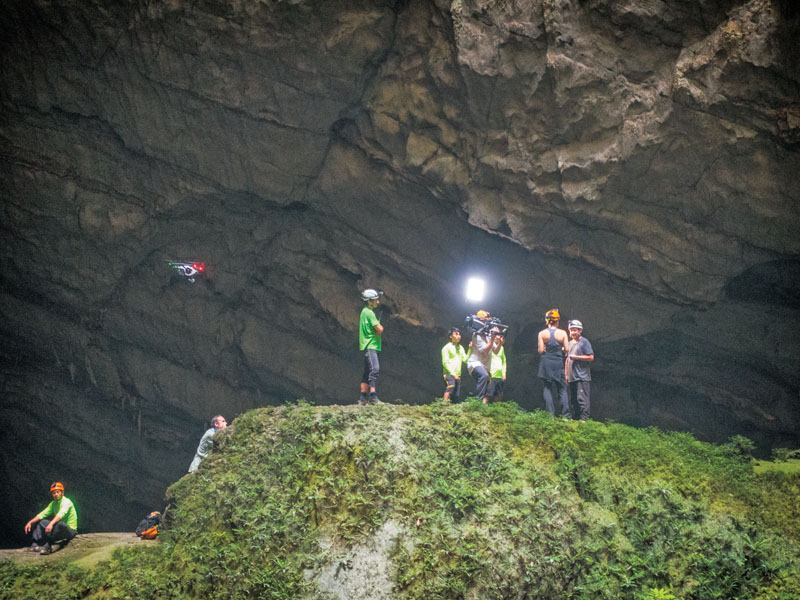
The ABC Good Morning America team uses a handheld camera to film a conversation between ABC’s Ginger Zee and Oxalis Adventure cave expert Howard Limbert, while we fly the DJI Inspire 1 for aerial footage.
This time we did not have to hike through the jungle. A huge Russian-made Mi-17 helicopter took a lot of our equipment and us from our home base deep into the jungle. That saved us so much energy—especially now that it had become even hotter and more humid.
We arrived in Hang En after a very short 1-hour hike from the helicopter landing site to the entrance of the cave. Both Ferdinand and I were capturing views from the air of the porters loading and unloading the over 100 cases of equipment for the entire team across the jungles, through the river to the entrance. While I was with the front group, Ferdinand was way in the back but we would fly along the entire line of people.
On this production trip we ensured that we had plenty of spare machines: we ended up with four Inspire 1s and three Phantom 3 Professionals. We had a total of 15 Inspire batteries and nine Phantom 3 batteries. While this sounds like a lot, it was just about the minimum. Yes, we did have a portable power generator but our charging times—and chargers—were limited. .
We put more focus on the Inspire, as this was the machine we needed to use for the live broadcast, so we wanted to have a spare machine each. The Phantom 3 was for capturing shots in Son Doong, together with the Inspire. While we planned to lose a machine or two, we ended up doing the entire project without a loss of aircraft. Both Ferdinand and I had a porter assigned to us to help us with the transport of an Inspire 1 and a Phantom 3 each, including batteries. The spare machines stayed behind in Hang En and if there was a need, one of the porters would hike back to Hang En and get it.

We brought four DJI Inspire 1 and three DJI Phantom 3 Professionals for this project. The equipment was transported in the dual setup cases from GoProfessional. Once inside the cave, we moved the equipment over to DJI soft and hardshell backpacks.
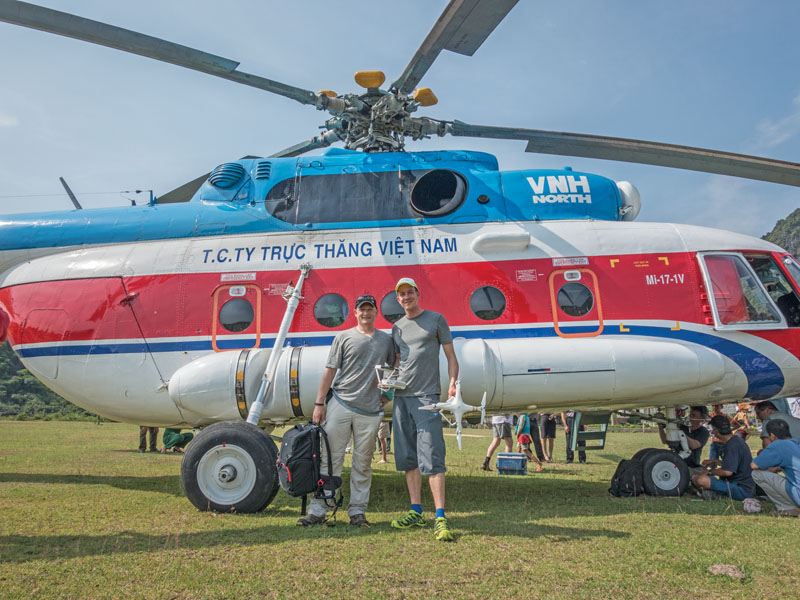
Russian Mi-17 helicopter helped us transport gear and people through the jungle. Ferdinand Wolf of Skynamics (left) and Romeo Durscher of DJI (right) are in front of this machine.
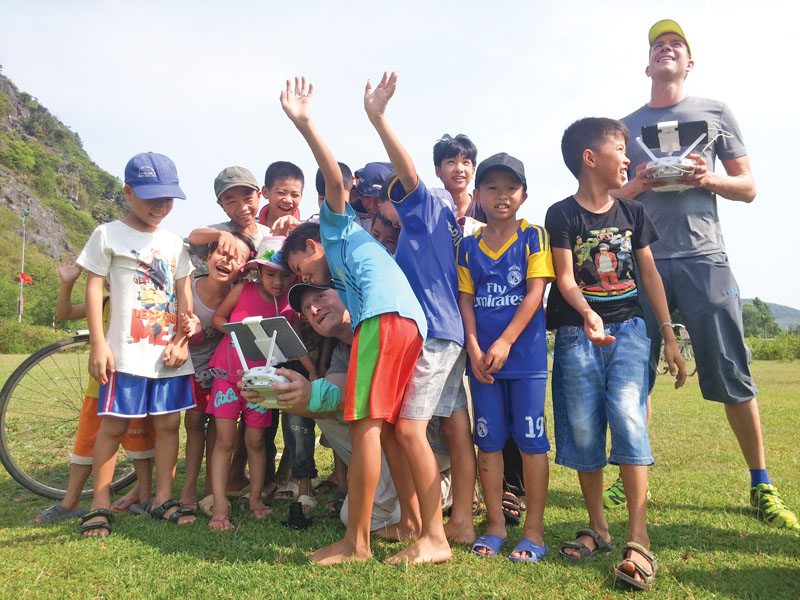
The helicopter landed just outside the village, and all of the kids came out not only to enjoy seeing a helicopter but also to explore the drones we were
flying.
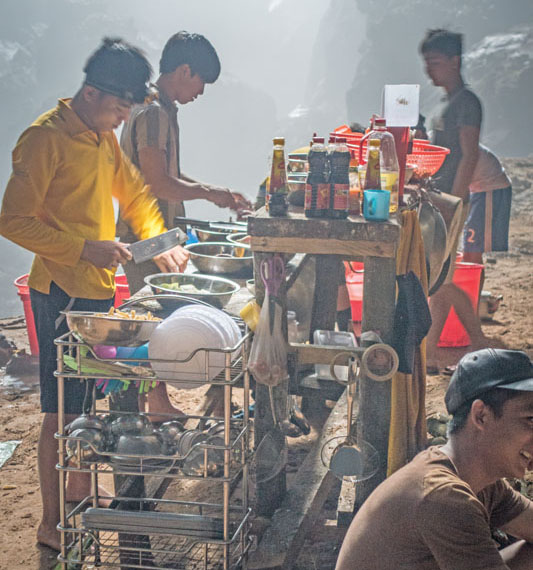
he Oxalis Adventure porters were also fantastic cooks, and despite being inside a cave, we ate very well.
A side trip
After a night in Hang En it was time for a small group, including ABC Good Morning America’s Ginger Zee, to make our way to the Son Doong cave. The rest of the team stayed behind and to build the satellite dish and assemble the lights to turn darkness inside the cave into an incredible image. After connecting all the cables and power generators to the needed equipment, they were able to pull this stunt off. During that time we were flying and tracking the progress from the air. Once our small group got to the exit, we had to trek along the river for a couple of hours before hiking up a mountain. Then it was time to tackle a steep mountainside to the entrance of Son Doong.
After a good hour ascent up a very steep mountain, we arrived at the last resting place before the real adventure started. We had some lunch, flew and then geared up for the descent into the darkness. We had to rappel down an almost 500-foot cliff. The farther down we got the darker it was. Now it was time to put the Phantom 3 up in the air and capture others coming down that wall. We captured views that nobody had ever seen before—and we were only at the entrance of this cave! We decided to whenever possible only fly one machine and help each other out. That turned out to be a good call as the environment was challenging to fly in and it helped having a spotter around.
Over the next few days we flew up to 12 flights a day inside the Son Doong cave. We would get up early, get our equipment together, have some wonderfully cooked and prepared breakfast and then start our hikes. Some were very challenging, going up steep inclines or climbing down walls. Oftentimes we arrived at a location and immediately unpacked our equipment and flew—without a break, still drenched in sweat from the hike and heart rates still very high, which made flying more challenging. Your entire body is tense and you have to be focused. By the latter part of the day I felt mentally and physically exhausted and flying really became more difficult.
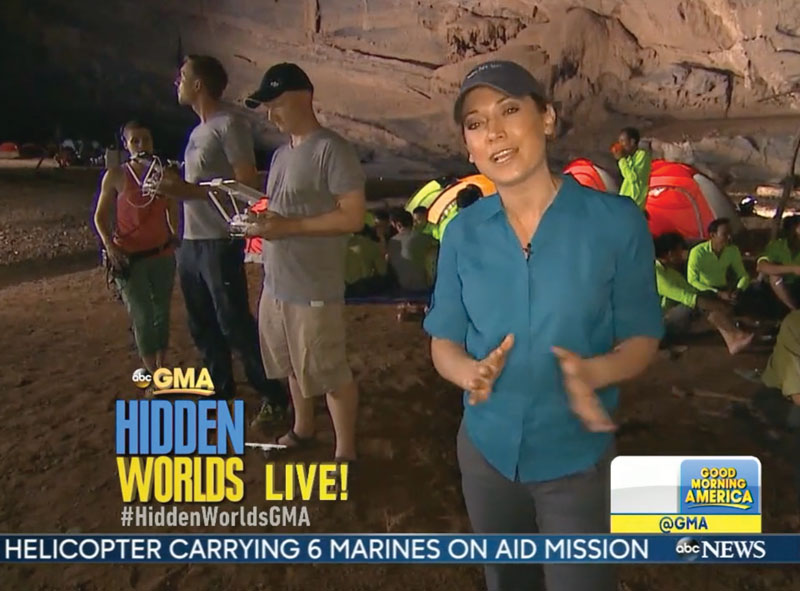
TV screenshot from the ABC Good Morning America live broadcast out of the Hang En cave. Our focus was intense!
Back for the live shot
By the end of the Son Doong trek, we had some incredible footage, which was fed to the ABC GMA studio in New York for editing. We climbed out of the Son Doong cave, hiked back to Hang En and started preparations for the live broadcast. After an afternoon of rest we practiced the evening before the live broadcast and did a drill broadcasting live to the studio so they could direct us with the shots they wanted. That was challenging, as we had to be in communications with the director so he could give us quick and precise instructions. For the live broadcast we decided to do the dual operator with the Inspire; Ferdinand piloted the quadcopter while I took over the camera control.
During the actual live broadcast we lost communications to the New York studio due to a thundercloud, so we had to be ready and in the air at all times. Exchanging batteries was a real challenge: we did not want to be on the ground when the call came back in for the live shot. We had to plan it really carefully and we had a lot of luck on our side. Eventually the communications came back up and things settled back in. The live shot looked great!
Needless to say, after the wrap everybody was very happy and excited. I walked away with a great story, an exciting adventure, some great videos and photographs and I got to the experience the warmth and kindness of the people who live in Vietnam.


